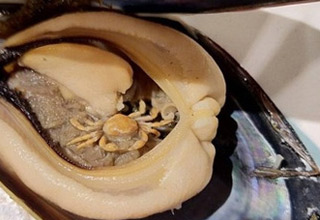Not just raw fish...
So what do you know about Japanese food? Raw fish and rice? If you are interested I'll explain a bit about the food here (if not feel free to get back to the thut and crust of the EBW blog wars).
This is about what we eat at home... eating out is a whole different story, and certainly enough for a blog entry on its own. We eat Japanese style four or five times a week, and Western style (although sometimes with a Japanese slant) the rest of the time. The most common Japanese meal consists of white rice (short grain, and quite starchy so it can be picked up with chop-sticks) and miso soup (basically a soup made with salty soya bean paste, to which can be added all kinds of meat, seafood and/or vegetables). The rice is usually served in a small bowl called a chawan (literally 'tea bowl' a style originally used for the famous Tea Ceremony), with salted vegetables (tsukimono) on a small side dish for each person. Then there are always several main dishes (O-kazu) that are shared between the family.
Popular (in my family) O-kazu include deep fried chicken (karage), grilled fish of all types, grilled seasoned chicken on skewers (Yaki-tori), pork cutlet deep fried in bread crumbs (tonkatsu), octopus pieces in batter balls (tako-yaki), grilled chinese style dumplings (gyoza) and deep fried seafood and vegetables in batter (tempura). We also really like raw fish (sashimi) which has to be really fresh and expertly sliced. Other seafood also eaten raw might include octopus (tako), squid (ika), various shellfish and (a particular favourite of mine) sea-urchin (uni). Sashimi is usually eaten with a small amount of soy sauce and grated green Japanese horseraddish (wasabi) which has a real bite to it.
Of course you have heard of sushi, but it may come as a surprise that this is not raw fish, but rice seasoned with slightly sweetened rice wine vinegar - vegetarian sushi (with cucmber (kappa makki), salted raddish (takuan makki), fermented soya beans (natto makki) or in pouches made from fried bean curd (kitsune sushi) are very popular. At home we often have sushi served in a large wooden bowl (a sushi oke) where we roll the sushi into sheets of grilled seaweed (nori) along with the fillings of our choice - avocado, tuna and cucumber with a squirt of mayonnaise works well, but the choice is very wide.
We also eat various kinds of noodles, thick white noodles (udon), grey buckwheat noodles (soba) and the chinese style noodles (ramen) in soup stock made with soya sauce and bonito flakes (katsuo), along with bean sprouts (moyashi), chinese style grilled pork (charshiu), chopped scallions (negi) and any other vegetables that seem suitable. Fried chinese style noodles (Yaki-soba) which are prepared with whatever meat and vegetables we have in the fridge, along with a thick brown sauce are also very nice. In the hot summer months, chilled noodles (hiyashi-chukka) go down well with sliced ham, cucumber, tomato and cold hard boiled eggs).
The Japanese also have their own style of curry, usually sold as blocks not unlike chocolate bars in shape and colour that can be disolved into a standard stew to produce a thick and fragrent curry. Similar blocks of stew flavouring can be used with chunks of meat (pork or beef) and potatos and then poured onto rice to make hayashi rice.
Spaghetti can also be given a distinctly Japanese taste. While all the familiar favourites (pomodoro, bolognaise, carbonara etc) are popular here, less familiar would be spaghetti with shimeji mushrooms and cream, or with cod roe (tarako spaghetti) or with very spicy cod roe (mentaiko spaghetti). My wife makes a brilliant sauce of her own devising using miso paste, cream and sliced shiitake (a kind of mushroom) - great for the taste buds but dire for the waistline.
All these will be washed down with liberal amounts of Japanese beer (very sharp, clean tasting and wonderful icy cold - at least it was before I had to give it up for the sake of my stomach :'( Meals always start with a hearty "kanpai" (cheers) and then "itadakimasu" (hard to translate - said before meals and any time you accept a consumable treat, it is literally "I will partake" but is just good manners).
This is just the tip of the proverbial iceberg - I'll add more gastronomic morsels as they occur. If you have got this far, thank you for reading. I'm off to go and cook dinner - "Itadakimasu"!






5 Comments